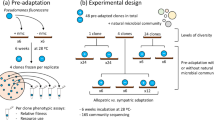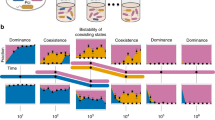Abstract
The species diversity of natural communities is often strongly related to their productivity. The pattern of this relationship seems to vary: diversity is known to increase monotonically with productivity, to decrease monotonically with productivity, and to be unimodally related to productivity, with maximum diversity occurring at intermediate levels of productivity1,2,3. The mechanism underlying these patterns remains obscure, although many possibilities have been suggested3,4,5,6. Here we outline a simple mechanism—involving selection in a heterogeneous environment—to explain these patterns, and test it using laboratory cultures of the bacterium Pseudomonas fluorescens . We grew diverse cultures over a wide range of nutrient concentrations, and found a strongly unimodal relationship between diversity and productivity in heterogeneous, but not in homogeneous, environments. Our result provides experimental evidence that the unimodal relationship often observed in natural communities can be caused by selection for specialized types in a heterogeneous environment.
This is a preview of subscription content, access via your institution
Access options
Subscribe to this journal
Receive 51 print issues and online access
$199.00 per year
only $3.90 per issue
Buy this article
- Purchase on Springer Link
- Instant access to full article PDF
Prices may be subject to local taxes which are calculated during checkout




Similar content being viewed by others
References
Tilman, D. Resource Competition and Community Structure (Princeton Univ. Press, Princeton, New Jersey, 1982).
Rosenszweig, M. L. Species Diversity in Space and Time (Cambridge Univ. Press, Cambridge, UK, 1995).
Waide, R. B. et al. The relationship between productivity and species richness. Annu. Rev. Ecol. Syst. 30, 257– 300 (1999).
Rosenzweig, M. L. & Abramsky, Z. in Species Diversity in Ecological Communities (eds Ricklefs, R. & Schluter, D.) 52–65 (Univ. Chicago Press, Chicago, Illinois, 1993).
Tilman, D. & Pacala, S. in Species Diversity in Ecological Communities (eds Ricklefs, R. & Schluter, D.) 13– 25 (Univ. Chicago Press, Chicago, Illinois, 1993).
Abrams, P. A. Monotonic or unimodal diversity-productivity gradients: what does competition theory predict? Ecology 76, 2019– 2027 (1995).
Odum, E. P. Fundamentals of Ecology (Saunders, Philadelphia, 1959 ).
Currie, D. J. Energy and large-scale patterns of animal- and plant-species richness. Am. Nat. 137, 27–49 ( 1991).
Abramsky, Z. & Rosenzweig, M. L. Tilman's predicted productivity-diversity relationship shown by desert rodents. Nature 309, 150–151 (1984).
Wisheu, I. C. & Keddy, P. A. Species richness-standing crop relationships along four lakeshore gradients: constraints on the general model. Can. J. Bot. 67, 1609– 1617 (1989).
Shipley, B., Keddy, P. A., Gaudet, C. & Moore, D. R. J. A model of species density in shoreline vegetation. Ecology 72 , 1658–1667 (1991).
Moore, D. R. J. & Keddy, P. A. The relationship between species richness and standing crop in wetlands: the importance of scale. Vegetatio 79, 99– 106 (1989).
Wheeler, B. D. & Shaw, S. C. Above-ground crop mass and species richness of the principal types of herbaceous rich-fen vegetation of lowland England and Wales. J. Ecol. 79, 285–301 (1991).
Bakelaar, R. G. & Odum, E. P. Community and population level responses to fertilization in an old-field ecosystem. Ecology 59, 660–665 ( 1978).
Goldberg, D. E. & Miller, T. E. Effects of different resource additions on species diversity in an annual plant community. Ecology 71, 213–225 ( 1990).
Wilson, S. D. & Tilman, D. Components of plant competition along an experimental gradient of nitrogen availability. Ecology 72, 1050–1065 (1991).
Al-Mufti, M. M. et al. A quantitative analysis of shoot phenology and dominance in herbaceous vegetation. J. Ecol. 65, 759– 791 (1977).
Yount, J. L. Factors that control species numbers in Silver Springs, Florida. Limnol. Oceanogr. 1, 286–295 (1956).
Schindler, D. W. Experimental perturbation of whole lakes as tests of hypotheses concerning ecosystem structure and function. Oikos 57, 25–41 (1990).
Levene, H. Genetic equilibrium when more than one ecological niche is available. Am. Nat. 87, 331–333 ( 1953).
Maynard Smith, J. & Hoekstra, R. Polymorphism in a varied environment: how robust are the models? Genet. Res. 35, 45–57 ( 1980).
Dempster, E. R. Maintenance of genetic heterogeneity. Cold Spring Harb. Symp. Quant. Biol. 20, 213–224 ( 1955).
Grime, J. P. Control of species density in herbaceous vegetation. J. Environ. Mgmt 1, 151–167 ( 1973).
Leibold, M. A. A graphical model of keystone predators in food webs: trophic regulation of abundance, incidence, and diversity patterns in communities. Am. Nat. 147, 784–812 ( 1996).
Holt, R., Grover, J. & Tilman, D. Simple rules for interspecific dominance in systems with exploitative and apparent competition. Am. Nat. 144, 741–771 (1994).
Rainey, P. B. & Travisano, M. Adaptive radiation in a heterogeneous environment. Nature 394, 69– 72 (1998).
Bell, G. The ecology and genetics of fitness in Chlamydomonas. V. The relationship between genetic correlation and environmental variance. Evolution 46, 561–566 ( 1992).
Bell, G. et al. The spatial structure of the physical environment. Oecologia 96, 114–121 ( 1993).
Simpson, E. H. Measurement of diversity. Nature 163, 688 (1949).
Acknowledgements
We thank K. McCann and D. Schoen for comments on an earlier version of the manuscript. This work was supported by the Canadian NSERC (G.B. and R.K.), the UK BBSRC and NERC (P.B.R. and A.B.) and the British Council.
Author information
Authors and Affiliations
Corresponding author
Rights and permissions
About this article
Cite this article
Kassen, R., Buckling, A., Bell, G. et al. Diversity peaks at intermediate productivity in a laboratory microcosm . Nature 406, 508–512 (2000). https://doi.org/10.1038/35020060
Received:
Accepted:
Published:
Issue Date:
DOI: https://doi.org/10.1038/35020060
This article is cited by
-
Linear and nonlinear effects of nutrient enrichments on the diversity of macrobenthos in lowland watercourses
Aquatic Ecology (2021)
-
Simulating eutrophication in a metacommunity landscape: an aquatic model ecosystem
Oecologia (2019)
-
Cyanobacteria dominance drives zooplankton functional dispersion
Hydrobiologia (2019)
-
Dual-stressor selection alters eco-evolutionary dynamics in experimental communities
Nature Ecology & Evolution (2018)
-
Interplay between productivity and regional species pool determines community assembly in aquatic microcosms
Aquatic Sciences (2018)
Comments
By submitting a comment you agree to abide by our Terms and Community Guidelines. If you find something abusive or that does not comply with our terms or guidelines please flag it as inappropriate.



